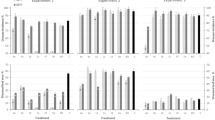Abstract
Metalaxyl, fosetyl-AI, calcium nitrate and phosphorous acid were tested in field trials against carrot cavity spot. Metalaxyl applied to soil at 1 kg/ha at the three to six trueleaf stage was the most consistently effective treatment, reducing the proportion of roots affected by at least 32%. Additional applications made 9-12 weeks later had no further effect on incidence of cavity spot. In one trial, a foliar spray with phosphorous acid at 4 g/l applied to run-off at the five to six true-leaf stage reduced incidence of cavity spot by 78% and increased root weight. Foliar sprays with calcium nitrate or fosetyl-AI had no effect on incidence of cavity spot.
Similar content being viewed by others
References
Cohen, Y. and Coffey, M.D. (1986)—Systemic fungicides and the control of Oomycetes. Annual Review of Phytopathology 24: 311–338.
Gladders, P. and Crompton, J.G. (1984)—Comparison of fungicides for control of cavity spot in carrots. Annals of Applied Biology Supplement 104: 36–37.
Lyshol, A.J., Semb, L. and Taksdal, G. (1984)—Reduction of cavity spot and root dieback in carrots by fungicide applications. Plant Pathology 33: 193–198.
Maynard, D.N., Gersten, B., Viach, E.F. and Vernell, H.J. (1961)—The effects of nutrient concentration and calcium levels on the occurrence of carrot cavity spot. Proceedings of the American Society for Horticultural Science 78: 339–342.
Saindrenan, P., Darakis, G. and Bompeix, G. (1985) —Determination of ethyl phosphite, phosphite, and phosphate in plant tissues by anion-exchange high-performance liquid chromatography and gas chromatography. Journal of Chromatography 347: 267–273.
Sanders, PL. (1984)—Failure of metalaxyl to control Pythium blight on turfgrass in Pennsylvania. Plant Disease 68: 776–777.
Tsao, PH. and Ocana, G. (1969)—Selective isolation of Phytophthora from natural soils on an improved antibiotic medium. Nature, London 223: 636–638.
Vaartaja, O. and Bumbieris, M. (1964)—Abundance of Pythium species in nursery soils in South Australia. Australian Journal of Biological Sciences 17: 436–445.
Wheatley, G.A., Hardman, J.A. and Edmonds, G.H. (1984) —Effects of metalaxyl and carbofuran in a fluid-drilling gel on cavity spot incidence and the yield of carrots. Annals of Applied Biology Supplement 104: 38–39.
White, J.G. (1986)—The association of Pythium spp. with cavity spot and root dieback of carrots. Annals of Applied Biology 109: 265–273.
Author information
Authors and Affiliations
Rights and permissions
About this article
Cite this article
Walker, G.E. Control of carrot cavity spot with metalaxyl and phosphorous acid. Australasian Plant Pathology 17, 41–44 (1988). https://doi.org/10.1071/APP9880041
Received:
Accepted:
Issue Date:
DOI: https://doi.org/10.1071/APP9880041




